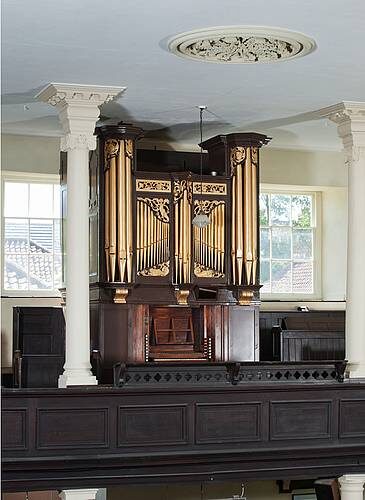The Organ of The Old Meeting House
 The façade of this instrument dates from 1664, and was the “chaire case” of the organ built for Norwich Cathedral by Robert Dallam in 1664. Dallam’s family returned to England upon the Restoration in 1660, when the need for organs here resumed. Dallam’s father, Thomas, had been collared by Elizabeth I in 1599, to make and deliver a combined clock and self- playing organ “to the Grand Turk, which will scandalise other Nations, especially the Germans”. This was by way of being a bribe to persuade the Sultan of Turkey to trade with England in preference to others. This story is available on the net in a re-print of Dallam’s diary called “Early Voyages and Travels in the Lavant”.The events recorded are scary, and make the story lines in the T.V. series “Blackadder II entirely plausible. The journey to Constantinople and back took over a year, and many lives were lost. Upon Thomas’s safe return he married and Robert was born and brought up in the family trade of organ building, which was regulated by the Guild of Blacksmiths. Trade secrecy was active to my own knowledge and experience until 1960!
The façade of this instrument dates from 1664, and was the “chaire case” of the organ built for Norwich Cathedral by Robert Dallam in 1664. Dallam’s family returned to England upon the Restoration in 1660, when the need for organs here resumed. Dallam’s father, Thomas, had been collared by Elizabeth I in 1599, to make and deliver a combined clock and self- playing organ “to the Grand Turk, which will scandalise other Nations, especially the Germans”. This was by way of being a bribe to persuade the Sultan of Turkey to trade with England in preference to others. This story is available on the net in a re-print of Dallam’s diary called “Early Voyages and Travels in the Lavant”.The events recorded are scary, and make the story lines in the T.V. series “Blackadder II entirely plausible. The journey to Constantinople and back took over a year, and many lives were lost. Upon Thomas’s safe return he married and Robert was born and brought up in the family trade of organ building, which was regulated by the Guild of Blacksmiths. Trade secrecy was active to my own knowledge and experience until 1960!
An interesting fact you might like to note is that when the organ was built around 15 years before J.S. Bach was born!
Robert Dallam’s instrument in Norwich Cathedral was taken down in 1689 and replaced with one by Thomas Harris, Robert’s son in law. Where the chair case of 1664 went after that we do not yet know. It has recently come to light that the OMH organ and case did not arrive until 1838 and came from the Bridge Street Concert room which stood in what is now St. Georges St ( nearby). The Hall Concert Society was founded around 1786 but as yet it is not known when they acquired the instrument, or from where.
The remainder of the organ consists of historic material from around 1750 to 1875, and is in itself a potted history of organ building over that period. Some later work was carried out by E. W. Norman, who with his brother Herbert went on to establish one of the largest organ building firms in the British Empire here in Norwich employing over 300 staff.
Organs of sorts have been made at least since 265B.C.(Greek) They were known to be in England in 1100. Informative fragments exist from the 1520’s. Organs were, until the advent of the clock the most complicated machines known to man. They have evolved according to the wealth of the Church, taste, fashion, the development of music, the endless possibilities afforded by the industrial revolution and beyond. The resulting explosion in technical ingenuity and the advent of new materials took organ building to new heights. In parallel go the architectural styles of the age, structural techniques and changing visual expression. Organs were first with programmable music… the barrel organ with pinned drum, others with perforated paper “recordings”, perforated card books, and now even midi interfaces for church pipe organs. Memories can store stop selections set up in advance of performance. The organ here needs none of this. All of it could have been made in the 17th century. Some of it was.
John Plunkett 2015